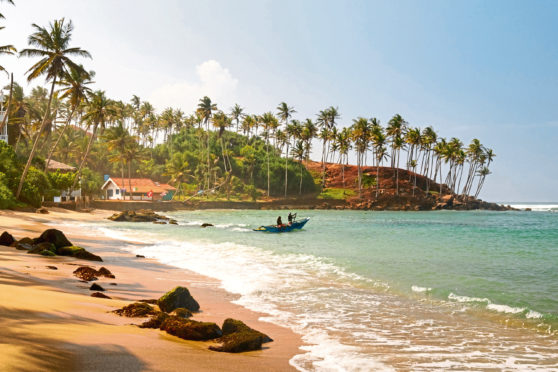
The drive from Colombo to Wilpattu National Park offers a sumptuous taste of Sri Lanka at its finest.
Roadside fruit vendors go about their business on the sandy earth, backed by tropical fields of coconut trees and palmyra palms. Beeping tuk-tuks and motorcycles glide by.
It all feels effortlessly cinematic, but then again, Sri Lanka is that kind of place.
In these coronavirus-stricken times, Sri Lanka presents welcome escapism, making it a strong contender for a dream holiday once this nightmare ends. But life hasn’t been easy for the country: terrorist bombings last Easter ground tourism to a halt, and now a pandemic is pushing businesses to the brink. People are clinging to the hope visitors will return – and they should. Our first day starts with an early-morning safari at Sri Lanka’s largest national park, Wilpattu, which in Sinhalese means Land of Lakes.
In a lake dense with lotus flowers, we spot a mugger crocodile and herd of water buffalo. Elsewhere a sambar deer holds our gaze and a golden jackal trots beside us.
All of a sudden, our tour leader Cham exclaims: “Look to your three o’clock!” Our Jeep stops as he points us in the direction of a leopard slumped on the bough of a tree. After a couple of minutes, it slides down the trunk and marks his territory before disappearing into the forest.
We stay the night at the nearby Mahoora, which claims to be the world’s first carbon-neutral mobile tented safari camp. It measures the carbon footprint of guests by the distance they’ve travelled and the length of stay. It then offsets the site’s overall footprint by purchasing carbon credits from a carbon-offset company.
The camp is almost 90% solar-powered and uses a zero-plastic and polythene approach. While each of the 10 tents comes equipped with a hot-water shower, living room and toilet, the manager assures me they can be stripped and removed in an hour, so nature can be restored.
Three of the five Unesco World Heritage Sites that make up Sri Lanka’s Cultural Triangle are within two-and-a-half hours’ drive of Mahoora. Viewing the forest plains from the top of 200-metre-tall Sigiriya rock fortress, then marvelling at the Buddha statues of Dambulla’s cave temples, makes for an unbeatable morning.
The southern hill country’s tea plantations are some of the most obvious vestiges of colonial times in Sri Lanka. The region can be reached by taking the rickety train journey from Kandy.
Tea-making was introduced to the country by the British in the 19th Century. Nuwara Eliya, is at the centre of this. Also known as “Little England”, it is a good base to explore the surrounding scenery, including Horton Plains National Park. A golf course, country clubs and Tudor-style post office decorate an area where visitors can ride ponies and go boating on the lake.
From Nuwara Eliya’s closest station, Nanu Oya, the same train line from Kandy takes you to Ella – a town surrounded by eye-catching hills and tea plantations. “Ella once used to be a transition town, but now it has turned into a backpackers’ paradise,” notes Cham. He puts this down to nearby hikes such as Little Adam’s Peak and Ella Rock.
We find ourselves eating juicy butterfish and red snapper on Mirissa beach, overlooking the lapping waves. At night, the beach is aglow with a fairy-lit stretch of bars and restaurants, where hermit crabs scuttle across the sand.
Our final evening is spent in the port city of Galle. Architecture recounts different periods of colonial rule: Dutch forces captured the city from the Portuguese in 1640 and the British arrived in 1796.
The ramparts of Galle Fort provide the perfect sunset-viewing platform. We encounter a Buddhist Sunday school, with children dressed in white following an orange-robed monk. The sea of kind, smiling eyes tells me Sri Lanka’s future is bright, and the country will always pull through hard times.
Factfile
Explore (explore.co.uk; 01252 883 512) offers a Highlights of Sri Lanka trip from £1,696 per person, including flights, accommodation, some meals and an Explore leader. For the latest updates on how the pandemic might affect your plans, visit
gov.uk/foreign-travel-advice
P.S.
Tea is Sri Lanka’s largest export. It is in the top five largest exporters of tea in the world and marked its 150th anniversary of tea exportation three years ago. Ceylon Tea, which Sri Lanka is renowned for, is ranked the cleanest in the world by the International Organisation for Standards.

Enjoy the convenience of having The Sunday Post delivered as a digital ePaper straight to your smartphone, tablet or computer.
Subscribe for only £5.49 a month and enjoy all the benefits of the printed paper as a digital replica.
Subscribe